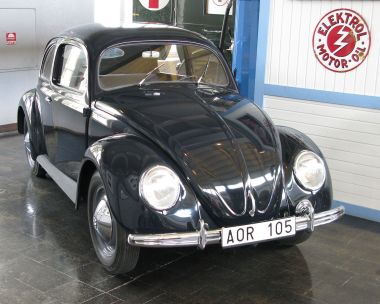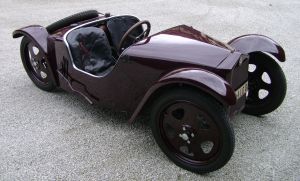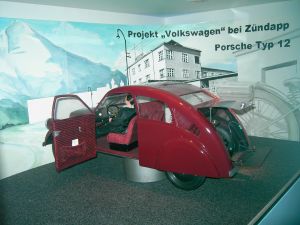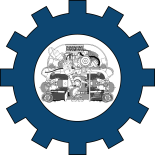Type 1: Difference between revisions
WestyMan1971 (talk | contribs) |
WestyMan1971 (talk | contribs) |
||
| Line 61: | Line 61: | ||
Production of the first car based on Josef Ganz's designs and patents began in 1933. The Standard Superior, built by Standard Fahrzeugfabrik, featured a body-on-tubular chassis, 2-stroke air cooled mid-engine, and independent suspension with rear swing-axles. This car was advertised as the German "Volkswagen," or "people's car," pre-dating the incorporation of [[Volkswagenwerk GmbH]] in 1937. Superior production ceased in 1935. | Production of the first car based on Josef Ganz's designs and patents began in 1933. The Standard Superior, built by Standard Fahrzeugfabrik, featured a body-on-tubular chassis, 2-stroke air cooled mid-engine, and independent suspension with rear swing-axles. This car was advertised as the German "Volkswagen," or "people's car," pre-dating the incorporation of [[Volkswagenwerk GmbH]] in 1937. Superior production ceased in 1935. | ||
Due to the antisemitic policies of the Nazi Party, Ganz's early concept of a "people's car" was never acknowledged | Due to the antisemitic policies of the Nazi Party, Ganz's early concept of a "people's car" was never acknowledged during his lifetime and has often been left out of official Volkswagen history. His influence on the development of the Beetle is still widely debated. | ||
==== Ferdinand Porsche's prototypes ==== | ==== Ferdinand Porsche's prototypes ==== | ||
[[File:Zundapp.jpg|thumb|left|Porsche Type 12]] | [[File:Zundapp.jpg|thumb|left|Porsche Type 12]] | ||
In 1931, Zündapp requested Austrian engineer [[Ferdinand Porsche]] design and build a prototype for an "everyman's automobile." This led to the development of three prototypes (two saloons and one coupe) known as the [[Porsche Type 12]]. These prototypes features a U-channel center beam chassis, leaf spring suspension, worm-gear steering and hydraulic drum brakes. The drivetrain consisted of a Zündapp-built five-cylinder radial engine (as opposed to Porsche's preferred [[flat-four engine]]) and a combined gearbox differential transmission joined by a wet single disc clutch. The Type 12 laid the basic design foundation for what would eventually become the Beetle. | In 1931, Zündapp requested Austrian engineer [[Ferdinand Porsche]] design and build a prototype for an "everyman's automobile." This led to the development of three prototypes (two saloons and one coupe) known as the [[Porsche Type 12]]. These prototypes features a U-channel center beam chassis, leaf spring suspension, worm-gear steering and hydraulic drum brakes. The drivetrain consisted of a Zündapp-built five-cylinder radial engine (as opposed to Porsche's preferred [[flat-four engine]]) and a combined gearbox differential transmission joined by a wet single disc clutch. The Type 12 laid the basic design foundation for what would eventually become the Beetle. | ||
Revision as of 16:38, 7 August 2023
| Beetle | |
|---|---|
 1949 Beetle Type 11 (Export Model) | |
| Overview | |
| Manufacturer | Volkswagen |
| Also called | |
| Production | 1938–2003: 21,529,464 built |
| Designer | Ferdinand Porsche |
| Variants | |
| Derivatives |
|
| Powertrain | |
| Engine | |
| Transmission |
|
| Dimensions | |
| Wheelbase | 2,400 mm (94.5 in) |
The Beetle—officially the Type 1, is an economy car that was manufactured and marketed by Volkswagen (VW) from 1938 until 2003.
It was designed by Ferdinand Porsche and features an air cooled rear-engine, two door coupe or cabriolet body-on-chassis design.
History
Josef Ganz's "Maikäfer" and the Standard Superior

The idea of a "people's car" can traced as far back as 1923, when a young Jewish Hungarian engineering student named Josef Ganz began sketching concepts for a "car for the masses." Ganz's design featured a mid-mounted engine, independent suspension and a streamlined body.
Being a student, Ganz did not have the funding to produce a prototype of his design, but instead began submitting articles on automotive design for various publications. Shortly after completing his studies in 1927, Ganz was hired as editor-in-chief of Klein-Motor-Sport (later renamed Motor-Kritik), where he continued to write articles promoting progressive design and the creation of a car for the masses.
In 1929, Josef Ganz contacted motorcycle manufacturers Zündapp, Ardie and DKW with assistance to build a prototype of his concept. The first prototype, the Ardie-Ganz, was built at Ardie in 1930 and a second one was completed at Adler in 1931, which was nicknamed the Maikäfer (‘May-Beetle').
Production of the first car based on Josef Ganz's designs and patents began in 1933. The Standard Superior, built by Standard Fahrzeugfabrik, featured a body-on-tubular chassis, 2-stroke air cooled mid-engine, and independent suspension with rear swing-axles. This car was advertised as the German "Volkswagen," or "people's car," pre-dating the incorporation of Volkswagenwerk GmbH in 1937. Superior production ceased in 1935.
Due to the antisemitic policies of the Nazi Party, Ganz's early concept of a "people's car" was never acknowledged during his lifetime and has often been left out of official Volkswagen history. His influence on the development of the Beetle is still widely debated.
Ferdinand Porsche's prototypes

In 1931, Zündapp requested Austrian engineer Ferdinand Porsche design and build a prototype for an "everyman's automobile." This led to the development of three prototypes (two saloons and one coupe) known as the Porsche Type 12. These prototypes features a U-channel center beam chassis, leaf spring suspension, worm-gear steering and hydraulic drum brakes. The drivetrain consisted of a Zündapp-built five-cylinder radial engine (as opposed to Porsche's preferred flat-four engine) and a combined gearbox differential transmission joined by a wet single disc clutch. The Type 12 laid the basic design foundation for what would eventually become the Beetle.
